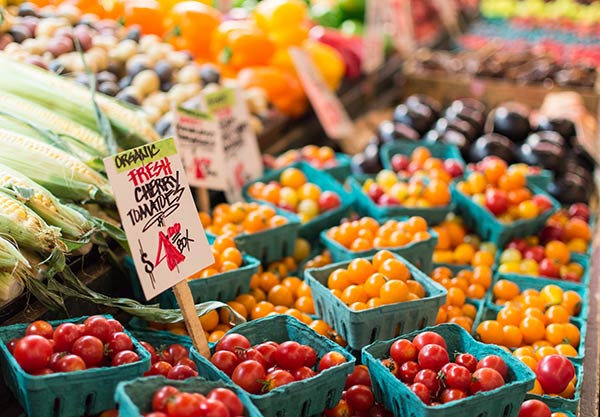
by Christine Jamieson
Every Saturday morning from May to October, and sometimes during the week, I plunge into a pool of color at the farmers market. In an instant, the world changes from green grass, gray roads and blue sky to vivid technicolor, with sheets of bright annuals—red, yellow, pink, purple, and silver. There are gorgeous perennials and mounds of vegetables in every shape imaginable, a feast for all the senses. Pick up cool, firm green asparagus, feel the hot, sun-ripened smoothness of tomatoes and peppers, the soft downy skin of a tawny peach, the gentle roughness of potatoes and carrots. The whole world is here!
And where did all these people come from at six o’clock in the morning, and all enjoying themselves? It’s as though a film director has gathered everyone together for a crowd scene: the elderly, the young, the middle aged, toddlers stooping to pick up fallen flowers, babies in strollers, dogs tripping up people and barking, geese honking overhead. It’s a summer fashion parade too: exotic hats, shorts, pretty dresses, as well as the more normal jeans, T-shirts and sweats.
Market season begins with the flower growers. In the first few weeks you can buy Michigan wildflowers, early spring-blooming perennials, marigolds, petunias, begonias and more unusual annuals, as well as cut bunches of daffodils, tulips and pussy willow with its furry white paws. The earliest produce includes spinach, asparagus and rhubarb. Sometimes there is a bag of dandelion leaves for salad—a wonderful system toner and tonic. In France, asparagus and artichoke salads rest on a bed of greens, which includes dandelion leaves as well as melt-in-the-mouth goat cheese tartlets, all garnished with sprigs of myrtle, rosemary and violet flowers—a delight to the eye as well as the palate.
Every week at market there is something new, as strawberries are followed by cherries, raspberries and blueberries. Then in the height of summer, the nectarines, apricots and peaches, and eventually the best-tasting apples you will ever find in the state. There are some unusual varieties, ones grown by Thomas Jefferson and George Washington, as well as the more usual Golden Delicious, McIntosh and Granny Smith. If you get the opportunity to sample a russet, Winesap, or an Arkansas Black, go for it. And try the yellow and white cherries in addition to the more traditional black. Occasionally someone will have gooseberries, but if you can’t find them, grow some yourself—one of the best is Poorman: a juicy, fat, red berry which is delicious in pies and crumbles.
Vegetables come and go, English and sugar snap peas, green and purple runner beans, tomatoes, corn, peppers and various brassicas with the last delight of the season, Brussels sprouts, always better after a touch of frost. If you look carefully, there are fingerling potatoes for salads, and sometimes lovely fresh laid eggs.
The perennials are different from week to week. There is a great selection of hardy geraniums and campanulas, unusual hellebores (H. foetidus and argutifolius, as well as orientalis and niger), burnets (Sanguisorba) with flowers like miniature bottlebrushes, and fern-leaf peonies. I searched for years for the potentilla ‘Primrose Beauty,’ a delicate creamy yellow color, and eventually found it, along with a variegated kerria.
Markets have been around as long as man has lived in towns and cities, farmers bringing in their produce to the agora in Greece or the forum in Rome. In Europe, meat, fish and cheese are available as well as produce. In colonial America too, markets were commonplace. When the state capital of Virginia moved from Williamsburg to Richmond in 1779, an ordinance was passed for the establishment of a ‘publick market.’ We are particularly fortunate to have so many in Michigan.
Many of the vendors are professionals, but there are some who have become so passionate about their hobby that they want to share it with others and make a little money while they are at it. The markets attract the young also. I talked to one young man selling strawberries and raspberries who was studying philosophy in college, and to another young couple who enjoyed the market so much that it became their livelihood. There are vendors turning sun-ripened olive oil and the essences of lavender and rose petals into soap; others displaying beautiful photographs of flowers; still others making wonderful dried flower wreaths and arrangements.
There are specialist growers also. At one market, small perennials are sold by an amateur enthusiast who wants to share the exciting plants he has grown from seed. There are people specializing in heirloom roses, Japanese maples, dahlias so perfect you cannot believe they are real, hard-to-find shrubs, and wonderful herbs.
So go to them all—the big markets as well as the smaller ones. Each has its own unique character and soon you will find your favorite. It’s the best way I know to spend Saturday morning.
Christine Jamieson is a Michigan gardener and writer.

Leave a Reply